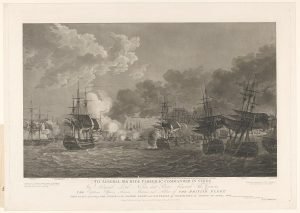Robert Haswell
c1724-1800.
Haswell appears to have joined the Navy in May 1737, and he was commissioned lieutenant on 8 July 1744.
On 26 March 1762 he was promoted commander of the bomb vessel Thunder 14 by Rear-Admiral George Rodney in the West Indies, serving at the capture of Havana in June, during which operation two of his ship’s mortars were landed. Returning to England in the winter, he paid the Thunder off on 24 February 1763.

When Haswell was eventually posted captain, he joined the Russell 74, shown here in action 21 years later at the Battle of Copenhagen.
Having seemingly remained unemployed for the next thirteen years, Haswell was appointed to the sloop Hornet 14 on 20 March 1776, which vessel was fitting out at Woolwich for service in the West Indies. His new command arrived at Spithead from the Downs in the middle of June with ten transports which were ultimately bound for America, and after sailing on a ‘secret mission’ from Portsmouth on 19 July, which was believed to be the conveyance of dispatches for America, she returned to Portsmouth from Ireland at the end of September. In November she departed for a cruise in the Channel to press seamen for the fleet.
At the beginning of December 1776, the Hornet sailed for Jamaica with a convoy of some thirty vessels and two other small men-of-war, and in April 1777 she joined the escort of the homeward-bound convoy from Bluefields, seeing it safely through the Gulf of Mexico. Later that summer she was engaged in convoy duty to the Mississippi and to Florida, and continuing on the Jamaican station, she sent in several prizes. On 1 August 1778 she departed the island with another convoy before returning to Kingston on 5 September.
On 22 May 1779 the Hornet reached Falmouth with the Jamaica convoy in the company of the Emerald 32, Captain Benjamin Caldwell, and days later she entered Portsmouth, having brought home dispatches from the governor of Jamaica. She was then taken into dock at Portsmouth for what appears to have been a thorough refit and coppering, and on Christmas Eve she sailed for Guernsey, prior to catching up with Admiral Sir George Rodney’s strong reinforcement for the Leeward Islands. During 1780 she was engaged in the convoying of troops to Antigua in January, St. Kitts in March, and St. Lucia in April.
After eighteen years in the rank of commander, Haswell was posted captain of the Russell 74 on 17 June 1780 by Admiral Sir George Rodney, which ship arrived at St. Lucia a day later from New York. He left her at Barbados on 30 January 1781, and after returning home he did not see any further employment.
In accordance with seniority, Haswell would have been promoted rear-admiral on 14 February 1799. He died a year later, in 1800.
His wife, Margaret, died at her residence in Millman Place, London, on 13 June 1809 at the age of 74.
Described as ‘tyrannical’ and a ‘flogger’, Haswell had Lieutenant Cuthbert Collingwood court-martialled for disobedience and neglect of duty on 30 September 1777 whilst on the Jamaican station.
